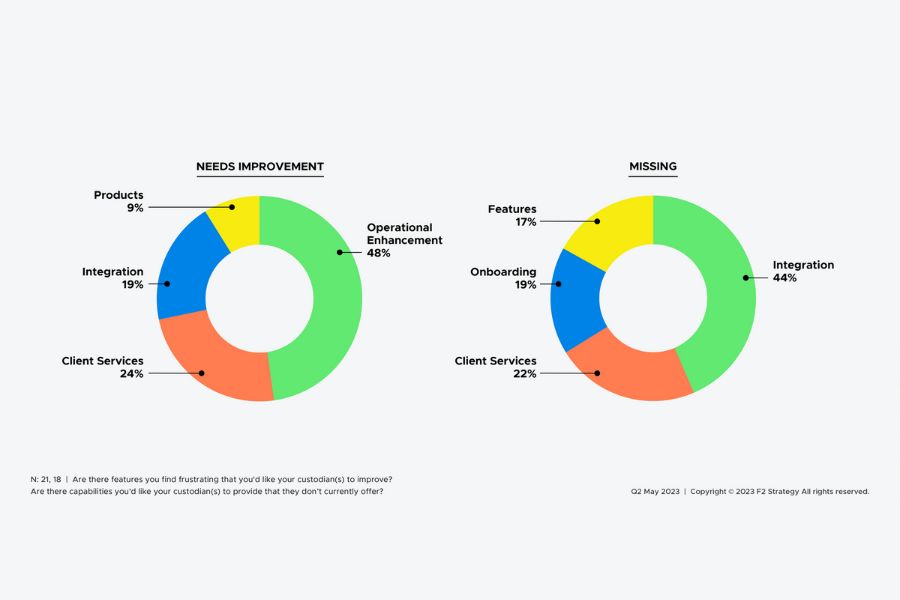

Since Charles Schwab first announced plans to acquire TD Ameritrade, much of the conversation in the wealth management industry has been about how the deal will impact the small financial advisory firms TD was known for supporting.
But large firms are also feeling confused about the current landscape of custodians, according to a survey from F2 Strategy, a consulting firm that works primarily with registered investment advisors, broker-dealers and asset managers with at least $1 billion in assets under management. In a survey of 29 firms that represent a combined $6 trillion in assets, F2 found it isn’t just small firms that are frustrated with a lack of integration, automation or innovation from their custodians.
Fewer than half of the firms polled are satisfied with native data download tools provided by their existing custodian, as opposed to 83% being satisfied with third-party data delivery tools. This may be the result of 70% of firms using at least two custodians.
Large firms will take the path of least resistance when recruiting new advisors. While working with multiple custodians brings a unique set of challenges, particularly in data management, it is typically less painful than the repapering process required to move client accounts to a new custodian.
“Each RIA may take a different approach to aggregating data and will expect their custodian to help them,” F2 founder and co-CEO Doug Fritz wrote in the report. “Currently, firms are not relying on their custodians for innovation and they want more out of what they have and will get it in whatever way they can to solve their challenges.”
Fritz was unable to provide additional comment.
Many large advisors are also disappointed in their custodian’s ability to integrate technology, a problem that is persistent across the independent advisor market. Of the firms polled by F2, 44% said their custodian doesn’t offer integration, while 19% said it needs improvement.

Firms want efficient processes for getting data from custodians into their own tools for processing and reporting, but there are still gaps, Fritz concluded.
“Given the collective frustration with the lack of integration and disappointment in the pace of innovation, it’s not hard to understand why most RIAs go to other vendors for more efficient technology,” he wrote. “Custodians should listen to their RIA clients to plan project roadmaps and update functionality that meets expectations.”

CEO Allen Darby sees a coming shift in M&A dynamics as AI eliminates clerical roles at RIAs, leaving buyers and sellers to negotiate who benefits from the added margin.

Michael Bell explains how the PE push in retirement plans will benefit investors, why warnings around risks may be overplayed, and what it will take to get plan fiduciaries comfortable with private investments.

Research highlights the dominant role of workplace retirement plans and breaks down the major factors dictating workers' IRA rollover decisions.

The wealth tech firm is rolling out its "Do Anything" assistant as leaders and strategists tout the next evolution of artificial intelligence.

Appeals court overturns SEC’s CAT funding plan, broker-dealers face new uncertainty.
Orion's Tom Wilson on delivering coordinated, high-touch service in a world where returns alone no longer set you apart.
Barely a decade old, registered index-linked annuities have quickly surged in popularity, thanks to their unique blend of protection and growth potential—an appealing option for investors looking to chart a steadier course through today's choppy market waters, says Myles Lambert, Brighthouse Financial.
